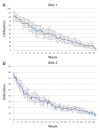Use of a computerized tracking system to monitor and provide feedback on dietary goals for calorie-restricted diets: the POUNDS LOST study
- PMID: 23063049
- PMCID: PMC3570857
- DOI: 10.1177/193229681200600527
Use of a computerized tracking system to monitor and provide feedback on dietary goals for calorie-restricted diets: the POUNDS LOST study
Abstract
The use of self-monitoring as a tool to facilitate behavioral modification is common in many lifestyle-based weight loss interventions. Electronic tracking programs, including computer-based systems and smart phone applications, have been developed to allow individuals to self-monitor their behavior digitally. These programs offer an advantage over traditional self-report modalities in that they can provide users with direct feedback about dietary and/or physical activity adherence levels and thereby assist them in real-time decision making. This article describes the use of an Internet-based computerized tracking system (CTS) that was developed specifically for the POUNDS LOST study, a 2-year randomized controlled trial designed to test the efficacy of four macronutrient diets for weight and fat reduction in healthy, overweight men and women (body mass index range = 25.0-39.9 kg/m(2)). The CTS served many functions in this study, including data collection, dietary and exercise assessment and feedback, messaging system, and report generation. Across all groups, participants with high usage of the CTS during the initial 8 weeks lost greater amounts of weight than participants with low usage (8.7% versus 5.5% of initial body weight, respectively; p < .001) at week 32. Rates of CTS utilization were highest during the first year of this 2-year intervention, and utilization of the CTS declined steadily over time. The unique features of the CTS combined with technological developments, such as smart phone applications, offer significant potential to improve the user's self-monitoring experience and adherence to health promotion programs designed specifically for individuals with obesity and type 2 diabetes.
© 2012 Diabetes Technology Society.
Figures



References
-
- Ogden CL, Yanovski SZ, Carroll MD, Flegal KM. The epidemiology of obesity. Gastroenterology. 2007;132(6):2087–2102. - PubMed
-
- Scheen AJ. The future of obesity: new drugs versus lifestyle interventions. Expert Opin Investig Drugs. 2008;17(3):263–267. - PubMed
-
- Perri MG, Foreyt JP, Anton SD. Preventing weight regain after weight loss. In: Bray GA, Bouchard C, editors. Handbook of obesity treatment: clinical applications. 3rd ed. New York: Informa Healthcare; 2011.
-
- Germann JN, Kirschenbaum DS, Rich BH. Child and parental self-monitoring as determinants of success in the treatment of morbid obesity in low-income minority children. J Pediatr Psychol. 2007;32(1):111–121. - PubMed
Publication types
MeSH terms
Grants and funding
LinkOut - more resources
Full Text Sources
Medical
Research Materials

